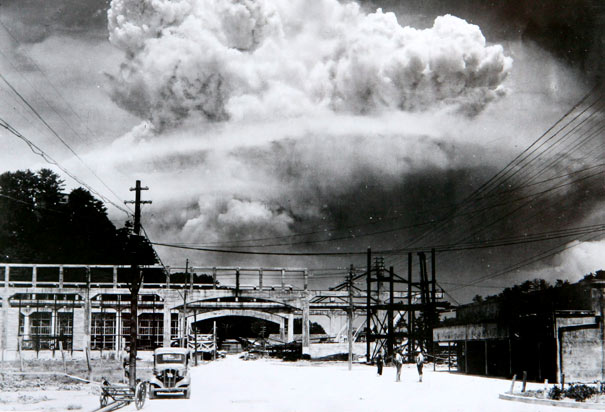 |
| What happens when Plutonium equal to half the mass of a penny fissions |
Nagasaki wasn't the primary target. The target planners were very interested in assessing the actual destructive capabilities of the atomic bomb, so they would only be used on previously un-bombed cities, in order to see how they performed against an entirely intact infrastructure. The primary target that day was Kokura, a historical city in the far southern end of Japan, just two hundred kilometers from the South Korean coast. But when the B-29 Bock's Car arrived over Kokura, early on the morning of August 9th, the city was obscured by clouds and smoke drifting from a major firebomb raid on Yahata the previous day. Having orders to drop the bomb using visual sighting methods rather than radar, the crew eventually decided to switch to the secondary target, the industrial port city of Nagasaki.
At 11:00 am the clouds cleared and the bombardier on Bocks Car, Captain Kermit Beahan, was able to visually sight the racetrack, which he used as his aiming point. The bomb detonated at 1650 feet, 3 kilometers northwest of the intended target, with a blast yield equivalent to 21,000 tons of TNT. The temperature at the blast center was over 7,000° Fahrenheit and the explosion generated winds in excess of 600 MPH. This bomb was somewhat more powerful than the one that was used over Hiroshima, but because the terrain was rolling hills, much of Nagasaki proper was protected from the blast effects and there was significantly less damage. For perspective, only about a gram of the approximately 6 kilogram Plutonium core actually fissioned before the heat of the explosion vaporized the bomb components.
The bomb that was used on Nagasaki, dubbed 'Fat Man', was of the Plutonium implosion type. This type of bomb was MUCH harder to design and build than the more basic 'gun type' fission device used in "Little Boy", the bomb that was dropped on Hiroshima. But it was much easier at that point for scientists to create weapons grade Plutonium 239 than it was to enrich Uranium to a purity that could be used in a bomb. In Fat Man, the Plutonium core would be compressed using a surrounding set of high explosive 'lenses' to the point where it would reach criticality and a fission reaction would begin. The engineering difficulty was the explosives had to detonate perfectly simultaneously, or the uneven forces would blow the core apart before it reached critical mass. The design team simply wasn't sure the bomb would even work, so they decided a real-world test was necessary before they turned the Fat Man over to the Army for delivery on Japanese targets. So on July 16, 1945, an identical device they called 'The Gadget" was exploded in a remote New Mexico desert in a test dubbed "Trinity".
The interesting historical question continues to be how Truman came to decide to use the atomic bomb at all, and then, why he decided to use a second one. There were those who believed that the US should detonate the first atomic bomb in an unpopulated area as a humane demonstration of its power and destructiveness. But Truman felt the Japanese would have to be shocked into surrendering, and the August 6th mission to Hiroshima was set in motion. But why the second bombing, at least so soon after the first? It's true that the second bombing was originally scheduled for August 11, but Colonel Tibbets moved it up to the 9th when weather reports indicated a full week's bad weather was closing in over Southern Japan. But even so, why not give the Japanese several weeks to comprehend the death and destruction they faced before hitting them again? My personal theory is that the second bombing wasn't intended to affect or influence the Japanese nearly as much as it was intended to affect and influence Josef Stalin and the Soviet Union, particularly with regards to the post-war power struggle over Eastern Europe and Germany.
Nuclear weapons have a complex legacy. On the one hand, the human race has lived in their shadow and the threat of civilizational destruction for generations. But on the other hand, that morning 69 years ago in the sky above Nagasaki still represents the last time one was used in anger. But the future is not written, and there's something close to a certainty that thermonuclear weapons will be used in a war before the end of humanity's reign. But the hope within the tragedy is that it will be a small, localized exchange. Nuclear nations have shifted to a 100KT range of weapons rather than five or ten MT "City Busters". If India and Pakistan fire a dozen modern nukes, it's not the end of the world and a lesson is there to be learned, hard and toxic but not terminal.
The threat of nuclear annihilation has profoundly changed the way nation-states interact with one another. The presence of such powerful weapons put an end to the escalation of large-scale regional and global conflict that characterized the 19th and 20th centuries. It is no longer possible for powerful nations to deploy massive armies in wars that lay waste to continents. In the shadow of the atom, warfare has changed, diplomacy has changed, trade has changed and the world is likely a better place right up until the moment when it all melts away under five thousand mushroom clouds. But for now, today, we remember the second, and final nuclear attack, the manifestation of applied technology and engineering prowess as remarkable as it was horrific.
...
No comments:
Post a Comment